State Lawmakers Must Help Launch a New Era of NYPD Transparency and Accountability
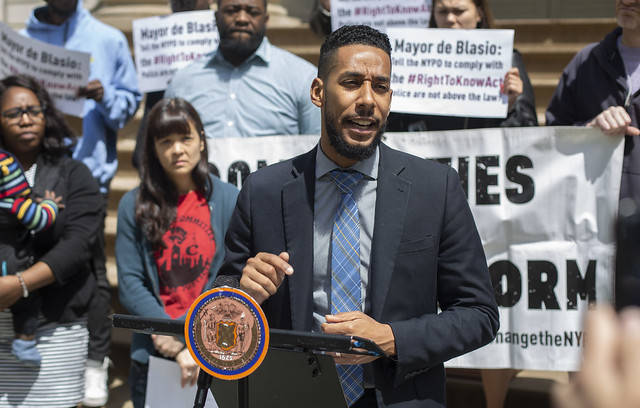
Council Member Reynoso, one of the co-authors (photo: John McCarten/City Council)
In recent history, New Yorkers have witnessed numerous instances of brutality and mistreatment at the hands of the police. Justice has not been delivered in many of these cases, and they all point to a glaring reality: a lack of transparency and accountability plagues the New York City Police Department.
The public was vividly reminded of this just a few weeks ago when a video of Christopher Parham’s 2018 arrest surfaced. In the video, 19-year-old Parham is seen picking up groceries for the restaurant where he worked when three plainclothes officers followed him outside of the grocery store and threw him to the ground, violently arresting him without cause. The officer who took him into custody – an officer with a history of civil rights lawsuits – and his colleagues slammed his head onto the sidewalk of a busy Williamsburg street, giving him a concussion and tasing him repeatedly before dragging him backwards by his handcuffed arms into a police car.
Despite the fact that this brutal assault occurred in broad daylight in front of witnesses, and was captured on cell phones and security camera, paperwork completed by the NYPD indicated that no force had been used during the arrest. The NYPD says an internal investigation cleared the officers who attacked him of wrongdoing.
The charges filed against Parham were eventually dismissed following the District Attorney’s review of surveillance footage obtained by Brooklyn Defender Services and our partnership advocating on his behalf. However, Parham’s experience with law enforcement is not unique, and residents of New York City are not strangers to officers with problematic histories patrolling their streets.
Stories like Parham’s are why we support the SaferNY Act, a package of bills currently in the New York State Legislature that aims to increase police accountability through measures such as repealing section 50-a of the state’s Civil Rights Law, which shields police personnel records; enacting the Police Statistics and Transparency (STAT) Act; and strengthening the role of the Special Prosecutor currently enacted by executive order.
Police departments in New York are tasked with disciplining their own officers, which means that officers who commit crimes, ranging from lying under oath to murder, are allowed to keep their jobs, even after an assessment of potential wrongdoing has been made. In this enormously flawed law enforcement disciplinary system – one where, for example, a finding of wrongdoing by the New York City Civilian Complaint Review Board and Internal Affairs Bureau investigations does not guarantee that officers are penalized – the personnel records of police officers remain sealed under 50-a.
Under 50-a, the information contained in personnel files, including investigations and findings of fact, are sealed from public scrutiny. This is problematic because the publicly available records paint an incomplete picture, one that judges and prosecutors are all too able to ignore at the NYPD’s urging. As a result, even when numerous public civil lawsuits have been filed, they are not considered as findings of fact or determinations of guilt and most of these cases settle out of court.
The public is starting to learn of some of the most problematic cases and worst offenders, however they have yet to be held accountable. As an example, Sgt. David “Bullethead” Grieco has been named in more than 30 lawsuits with allegations including physical violence and lying under oath. Yet despite his egregious track record, cases brought by this officer are still being prosecuted.
If we want a city that is safe, fair, and equitable, we must hold all citizens to the same standards and levels of accountability, including members of our law enforcement. It shouldn’t take a City Council member and advocates to join forces to protect individuals like Christopher Parham from those who are supposed to protect us.
Parham wants to move on with his life, “I just don’t want this to happen to anyone else,” he says. It is in the hands of the New York State Legislature to get us closer to this goal, and that is why we urge our state lawmakers to pass the SaferNY Act before the end of this session in Albany.
***
City Council Member Antonio Reynoso represents parts of Brooklyn and Queens. Lisa Schreibersdorf is Executive Director and Founder of Brooklyn Defender Services. On Twitter @CMReynoso34 & @lisaschreib.
***
Have an op-ed idea or submission for Gotham Gazette? Email This email address is being protected from spambots. You need JavaScript enabled to view it.
Reorganizing the MTA with a Transparent, Public Process
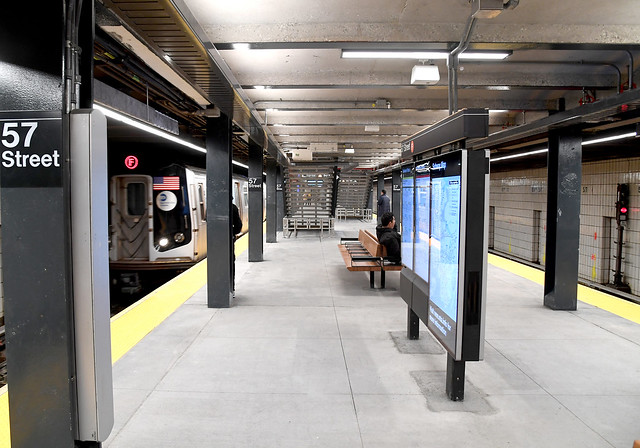
(photo: Marc A. Hermann / MTA New York City Transit)
In advance of the MTA Board meeting taking place today (Wednesday, May 22), Reinvent Albany and ten other groups including Riders Alliance, TransitCenter, Regional Plan Association, and others sent a letter asking the Metropolitan Transportation Authority (MTA) to make sure that the process for developing its reorganization plan -- as required by this year’s state budget -- is public, transparent and consultative.
At a time when the MTA has been seeking to restore the public’s trust, it is as important as ever that a reorganization is not disruptive to riders, who are counting on a reorganization to provide better, not worse, service. Ensuring the discussions over the pending reorganization are open and consultative will help put the MTA’s best foot forward to show it is acting in the public interest -- something highlighted as a major need in Reinvent Albany’s recently-released Open MTA report.
So far, the process has not been public or transparent, and MTA Board members have raised important questions about their role. In March, before the state budget legislation was passed creating the mandate for reorganization, the Board was asked by MTA management to approve a contract with consultants AlixPartners. Once the budget was finalized and passed, at the April Board meeting, a $4 million contract was approved for AlixPartners to develop the reorganization plan.
While the law sets up milestones for the process to unfold, there is no detail on how the public is to be engaged in the process, and little detail on how the plan is to be presented to the public. The state budget requires the MTA’s consultant, now AlixPartners, to give its plan to the MTA Board by June 30 of this year. Our view is that the plan should be made public at that date, including any accompanying analyses.
AlixPartners is also conducting a “review” of waste, fraud, abuse, conflicts of interest, duplications of functions, etc., which is due to the MTA by July 31. Under law, the “review” is to be made public within 30 days of receipt by the MTA.
Best would be to make the AlixPartners “review” public as soon as it is received by the MTA Board, since there is a narrow window of time for adopting the reorganization plan. Within 90 days of receipt of this “review,” the reorganization plan is to be “updated” by the authority to incorporate its findings.
It is our understanding that the MTA Board, acting as the authority, will vote on a final reorganization plan sometime before the end of October of this year. Well before a final plan is voted on, the MTA Board and staff should reach out to public stakeholders, including riders groups, unions, advocates, and elected representatives, and publicly consult with them about potential recommendations. This would be best done outside of the MTA Board meeting process, which limits public engagement to 2-minute presentations and does not allow a dialogue to occur.
Beyond ensuring that the reorganization plan process is open and consultative, as supported by our partners, Reinvent Albany has a number of questions about the ramifications of the plan itself that we would like the MTA to answer:
- The MTA’s efforts to consolidate invoice payments, human resources, and IT functions under the Business Services Center (BSC) have not been independently evaluated, though general consensus is that the effort was rocky at first, though appears to be moving in the right direction. What has the MTA learned from this past consolidation that should apply to the current reorganization process? Reports on the BSC from MTA show that its current mandate is considerable.
- How will the plan ensure that the MTA’s professional staff are allowed to have independence, and be free from the past politicization that has plagued the MTA?
- What will be the role of agency presidents going forward? Andy Byford has hired considerable talent, including, for example, Sarah Meyer (Chief Customer Officer), and Pete Tomlin (signals technology expert). How will this staff talent be retained and used in the future?
- How will the plan ensure that there is not further brain drain, and work to boost MTA staff morale? The hiring freeze has put considerable strain on current MTA staff to already do more with fewer resources (in some cases necessitating overtime), and morale appears to be at an all time low.
- How will the state budget provision that enables sharing of employees facilitate reorganization? How will any sharing of employees be reported to the MTA Board and public? How will collective bargaining agreements affect the proposed reorganization/employee sharing?
- How will the plan address transparency and accountability? MTA CEO/Chair Pat Foye has promised to overhaul the Freedom of Information Law (FOIL) process and Open Data at MTA, yet the Information Technology (IT) department has already been consolidated, resulting in the elimination of 187 positions, in addition to the current hiring freeze.
Reinvent Albany also has concerns that this IT consolidation is creating an outsourcing trap for the MTA that results in dependency on outside, costly consultants. Transparent efficiency efforts rely on IT staff having the people, resources, and political will to make changes. Will they?
The MTA should seek to answer these questions -- and those of other stakeholders -- in a public, consultative process. MTA riders and taxpayers deserve nothing less.
***
Rachael Fauss is Senior Policy Analyst at Reinvent Albany. On Twitter @RachaelFauss & @ReinventAlbany.
***
Have an op-ed idea or submission for Gotham Gazette? Email This email address is being protected from spambots. You need JavaScript enabled to view it.
Restoring Access to Driver’s Licenses Will Make New York Roads Safer
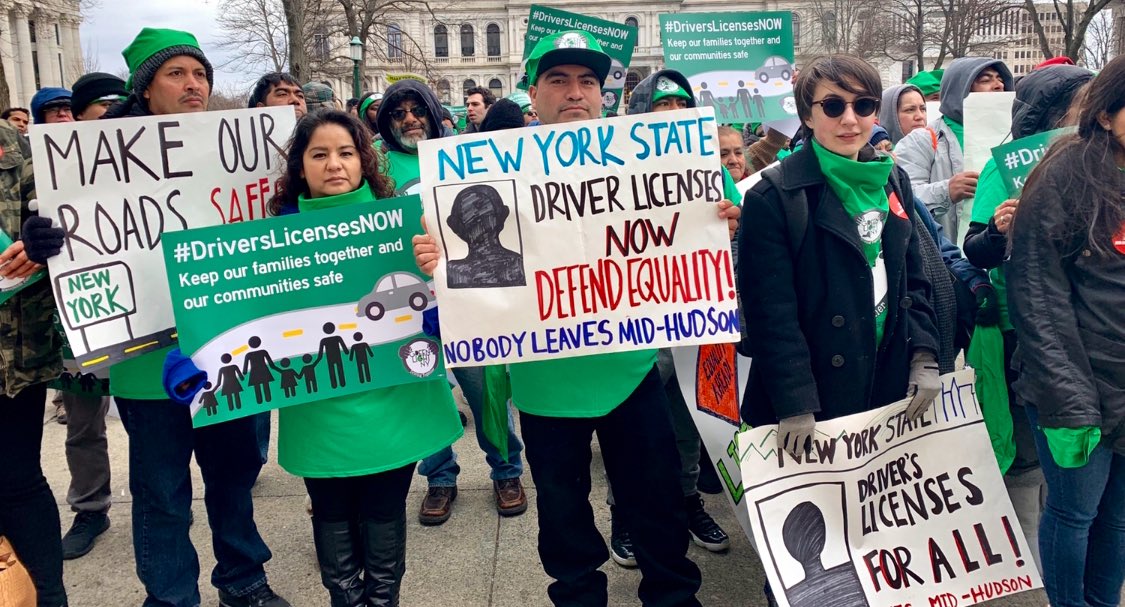
(photo: @EddieATaveras)
As a former Suffolk county police officer and detective, I think a lot about what keeps our communities safer. And one thing I know is that our roads are safer when everyone who is driving is licensed and insured. That’s why, as a state legislator, I believe New York should let all qualified drivers, regardless of immigrant status, follow the same process to get a driver’s license.
Driving is essential on Long Island. Throughout most of our region, you need a car to get to work and to drive your child to school or the doctor. Passing the Driver's License Access and Privacy Act would mean that 265,000 New Yorkers, including 51,000 Long Islanders, who currently don’t have access to a license would be able to safely drive to carry out their basic daily life necessities.
The roads in our state will be safer because every driver will go through the same process: submit an application, take a road test, and, if you pass, obtain a license. Making sure all drivers are licensed and insured means that more drivers are aware of traffic regulations and will likely reduce traffic-related incidents.
Roads are safer when all drivers can be tested, licensed, and insured. While research has shown that undocumented immigrants are particularly careful drivers, they are even safer when they have a state issued driver’s license. Various studies have concluded that ensuring equal access to licenses can reduce the incidence of traffic fatalities. And, in California, data show that within the first year of passing a similar policy to expand access to driver’s licenses, the number of hit-and-run accidents declined.
In addition to making our roads safer, restoring access to driver’s licenses to all New Yorkers can help build trust between local law enforcement and immigrant communities – a relationship that has been crippled by a series of attacks on immigrants and people of color by the Trump administration; the president went as far as encouraging police brutality in a 2018 visit to Long Island.
In the climate of fear that Donald Trump has created, members of our communities are more fearful than ever of interactions with law enforcement, which can lead people to not report crimes that they witness or of which they are victims. This is especially true when people don’t have access to a state identification document.
No one, regardless of immigration status, should have to fear contacting a police officer, whether it is to ask for help or to contribute to a solving a crime, for lack of documentation. Having a driver’s license will lead to thousands more current New Yorkers having access to an identification document that enables them to identify themselves as they drive on the road and proceed with their daily lives.
Restoring access to driver’s licenses will also be an economic win for our state. Immigrant New Yorkers already contribute enormously to our state’s economy -- contributing more than $100 billion annually as consumers, and more than $1 billion in taxes on top of that.
If the driver’s licenses bill, which would especially increase the number of immigrants with licenses statewide, were passed, the Fiscal Policy Institute has found there would be a further gain. Annual state revenues would increase by $57 million, and there would be a $26 million one-time boost in revenue, as people obtain licenses and purchase cars.
It’s also worth noting what this bill won’t do. The standard issue licenses that would be available to undocumented people would not be valid for air travel, for entering federal government facilities, or to vote. The standard licenses would simply enable members of our communities to access the roads and the insurance they need.
The Driver's License Access and Privacy Act would bring benefits to all Long Islanders through improved road safety, trust in law enforcement, and an economic boost. New York should not delay. This should be the year to restore access to licenses to all qualified drivers.
***
Phil Ramos is an Assembly member representing New York’s 6th Assembly District in Suffolk County. On Twitter @PhilRamos6AD.
***
Have an op-ed idea or submission for Gotham Gazette? Email This email address is being protected from spambots. You need JavaScript enabled to view it.
The Next Battleground in the Fight to Close the Rikers Island Jails
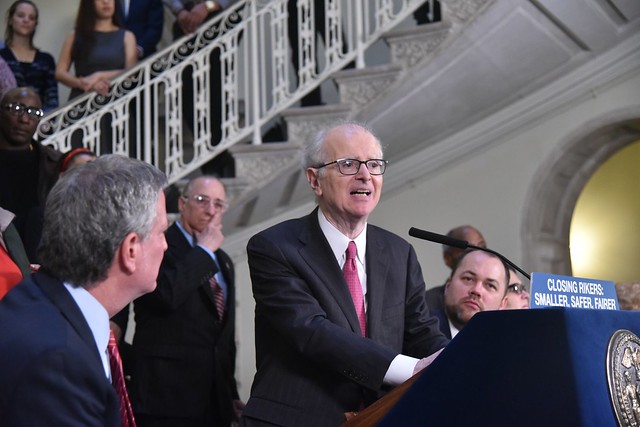
Jonathan Lippman, one of the authors (photo: John McCarten/NYC Council)
The New York State Legislature recently passed a landmark suite of criminal justice reforms that will profoundly re-shape the justice system in New York. Among other things, the reforms should help recalibrate the balance of power between prosecutors and defense attorneys and accelerate the effort to close the notorious jail complex on Rikers Island.
A recent analysis found that by reducing the use of bail, the legislative reforms would result in the release of more than 40% of the defendants held in pretrial detention in New York City.
Legislative changes like these almost always generate significant public attention -- newspaper headlines, social media traffic, and the like. But if we hope to create a justice system that truly serves as an international model of fairness and effectiveness, we cannot rely solely, or even primarily, on legislation.
The kind of cultural change that is required in New York cannot simply be imposed from on high by political actors; it must be embraced by frontline practitioners – judges, attorneys, police officers, and others. These officials must be given the tools they need to both maintain public safety and ensure that every defendant and every victim is treated with dignity and respect.
This means making long-term investments in training and education – for example, teaching justice officials about the long-lasting effects of trauma among the justice-involved population. It means reshaping the physical plant of the justice system so that our police precincts and courthouses and jails are designed to welcome rather than intimidate users. And it means focusing in the trenches on boring and technical issues like the speed with which cases are processed by the justice system.
Take felony cases. New York’s court system has long expected felonies to be resolved within 180 days of an indictment. Yet, among indicted felonies resolved in 2018 in New York City, despite the herculean efforts of court administrators, cases averaged more than ten months to a resolution. Shortening this timeframe doesn't make sense just from an efficiency standpoint -- it should also help reduce the jail population in New York City, since many of these defendants are currently detained on Rikers Island while their cases are pending.
The new legislative reform should make a real difference -- most discovery becomes automatic and must be completed within 15 days of arraignment. Chief Judge Janet DiFiore has also made inroads in recent months, employing new technology, changing judicial assignments, and using her bully pulpit to make improved timeliness the top judicial priority.
And, yet, there is still enormous potential for delay within the courts. What else can be done?
Judges and attorneys can take several practical steps to make the constitutional right to a speedy trial more of an everyday reality.
For one, the parties can shrink the number of days in between each court appearance. In 2016, the Office of Court Administration endorsed a 30-day cap. As adjournment length declines, there will be less idle time waiting for the next court date.
Second, once discovery is complete, judges can make it a routine practice to convene attorneys in a case conference outside the courtroom. A conference is an opportunity to have an honest discussion about the strengths and weaknesses in each side’s case and, potentially, to reach a good faith plea agreement sooner rather than later in case proceedings.
Third, judges and attorneys can agree to formal guidelines up front that state exactly what each party is responsible for accomplishing in between each court appearance -- in lieu of constantly reassessing progress at each successive court date.
Earlier this year, the Brooklyn Supreme Court, with the cooperation of the Brooklyn District Attorney and the local defense bar, launched an experiment that seeks to move in these directions. With support from the Art for Justice Fund and the Center for Court Innovation, the parties agreed to use a case processing roadmap that clearly defines what should happen from one court appearance to the next in indicted felony cases.
The Brooklyn pilot is an attempt to implement case processing reforms recommended by both the Mayor’s Office of Criminal Justice and the Independent Commission on New York City Criminal Justice and Incarceration Reform. If successful, it can potentially serve as a model for the rest of the city.
To close the Rikers Island jails and create a better justice system is a complicated endeavor that will require sustained effort over the course of many years. Policy, at both the city and state level, has an important role to play. But so does practice.
There aren’t going to be any ticker-tape parades when felony cases are resolved four months quicker, but it is precisely these kinds of changes that are the critical next frontier in the fight for criminal justice reform in New York.
***
Jonathan Lippman is a former chief judge of New York State, of counsel at Latham & Watkins LLP, and chair of the Independent Commission on New York City Criminal Justice and Incarceration Reform. Greg Berman is Director of Center for Court Innovation.
***
Have an op-ed idea or submission for Gotham Gazette? Email This email address is being protected from spambots. You need JavaScript enabled to view it.
As Public School Parent Leaders, We Say Don’t Raise the Charter Cap

(photo: Governor's Office)
There has been much discussion that the state Legislature and Governor Cuomo may raise the cap on charter schools, especially since the sub-cap of 235 charter schools in New York City has now been reached. As public school parents and co-chairs of the Education Council Consortium, which represents the elected parent leaders of Community Education Councils across the five boroughs, we overwhelmingly oppose raising the cap because this would have a seriously detrimental impact on our public schools.
Privately-run charter schools in New York City are already costing the Department of Education more than $2.1 billion a year. In addition, the city is required to pay for private space for all new and expanding charter schools if they are not given space in our already overcrowded public schools – the only district in the state and the nation that is so obligated. The cost to the city for this private space is rising fast, as our existing charters continue to expand to new grade levels.
On average, charter schools enroll far fewer special needs students and English Language Learners than other public schools. If the Legislature allows charters to continue to proliferate, our public schools will be even more concentrated with the highest needs students in less space and with fewer resources to educate them. Some of the fastest growing charter chains, including Success Academy, have been sued repeatedly for pushing out students and violating their civil rights, especially children with disabilities. The State Education Department has recently ordered that Success adopt a corrective action plan to cease these discriminatory practices.
The charter school waiting lists of 50,000 students are often cited as a reason to raise the cap. However a few points about these lists should be made: First, no one audits the figures claimed by charters and many students are double or triple counted if they apply to more than one charter school, as commonly occurs. When charter waiting lists are audited, as happened in Boston, their figures were found to be inflated. We also know from a recent research study that 50 percent of the students accepted by lottery to Success Academy do not end up enrolling in their schools; which means that thousands of students are accepted off their waiting list without any need to raise the cap.
Some charter schools spend thousands or even millions of dollars on advertising on radio, subways, bus stops, social media, and glossy mailings to build up their waiting lists. This process is encouraged by the mayor, who allows charter schools, including Success Academy, Uncommon, KIPP, and Achievement First, to use Department of Education mailing lists to send promotional materials to families to market their schools.
Success Academy itself has what is described as a “full service brand strategy, marketing and creative division” including an advertising staff of more than 30 creative directors, designers, copywriters, strategists and project managers, an expense which no public school can afford.
Even so, the city’s public schools have longer waiting lists. This year, there were more than 155,000 instances in which the city’s 8th grade students applied but weren’t admitted to 21 of the most popular public high schools for lack of space. Many of the students who landed on these waiting lists were probably double- or triple-counted of course, just like students on the charter school waiting lists. Yet this represents only a small fraction of the waiting lists at the 1,800 public schools across the city, which spend no funds on advertising or glossy mailings.
What is tragic is how, unlike charter schools, the city’s most popular and successful public schools, are prevented from expanding or replicating by insufficient space and funding, which would be further diminished if the charter cap were raised.
As a city and a state, we must focus on supporting and improving our public schools, rather than encourage the growth of privately-managed charter schools that pull resources from them.
Public education is the cornerstone of our democracy and it is the Legislature’s responsibility to acknowledge that fact by keeping the cap on charters in New York City and statewide.
***
NeQuan McLean and Shino Tanikawa are Co-Chairs, of the Education Council Consortium. On Twitter @CNequan & @estuaryqueen.
***
Have an op-ed idea or submission for Gotham Gazette? Email This email address is being protected from spambots. You need JavaScript enabled to view it.
Pass the Off Fossil Fuels Act, New York’s Strongest Climate Change Bill
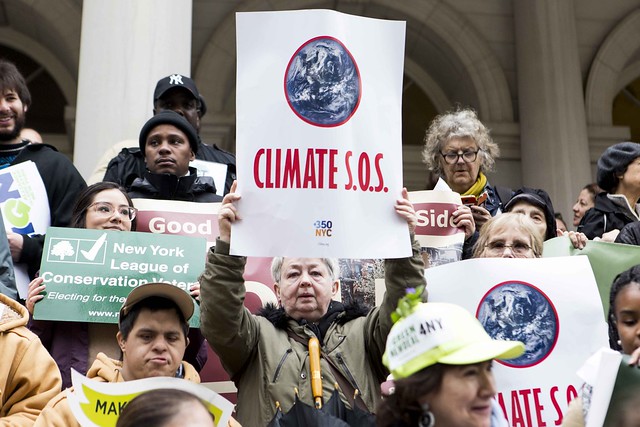
(photo: Emil Cohen/City Council)
Grassroots climate activists hope that before state lawmakers adjourn for the summer they will strike a deal with Governor Cuomo to adopt the strongest climate legislation possible.
And let’s be clear: the strongest climate bill is the NYS OFF Act (A3565/S5526), not the more publicized Climate and Community Protection Act (CCPA).
The Off Fossil Fuels Act, for 100% renewable energy by 2030, grew out of the successful grassroots campaign to ban fracking in New York. It seeks to implement the study done by Stanford and Cornell professors showing how the state could by 2030 obtain 100% of its energy from solar, wind, geothermal, and conservation. It includes the critical component of calling for a halt to all new fossil projects, a measure not included in either the CCPA or by the governor in his agenda. Forty state lawmakers are sponsoring the OFF Act.
The CCPA deserves praise for making environmental justice and a “just transition” central objectives of any climate action. But its climate policies are centered around enacting into law a ten-year-old Executive Order from the Paterson administration. The bill that the State Assembly passed every year since 2009 to do that was changed three years ago to the CCPA, adding environmental justice and labor provisions.
Our understanding of climate change has itself changed a lot in the last decade, especially so in the last three years. The climate goals in the CCPA were rejected by developing countries at the Paris climate talks. They rebelled against the industrial polluter nations which want a goal of keeping global warming below 2 degrees Celsius, insisting the target be lowered to 1.5 degrees.
The International Panel on Climate Change (IPCC) recently warned the world that it had to significantly step up its climate actions as we have less than 12 years left to save life on the planet. The IPCC is a conservative body, due to the nature of “scientific consensus” and because its pronouncements need to be approved by the fossil-fuel centered countries like Saudi Arabia, the United States, Russia, and Brazil. Every study by the IPPC has understated the speed and severity of climate change. As one of its authors has said, for an accurate read, take our worst case scenario and double it.
Even Governor Cuomo upgraded his climate goals following the IPCC report, now calling for 70% of state electricity to be renewable by 2030.
I spent more than three decades organizing for a variety of low-income community groups to end poverty and promote economic justice. We cannot solve the climate crisis without ensuring that the poor and workers benefit from the transition. While dedicating jobs and climate funding to lift up disadvantaged communities, we need to advocate for policies that ensure such communities are not blown, washed, or burnt away by extreme weather.
We need to remember that it is the developing world that is home to the principal victims of climate change. Half of the residents of Puerto Rico were without electricity and drinking water for six months – and they are part of the United States (despite how the Trump administration may approach them)!
Scientists now openly discuss the possibility of human extinction and/or the end of civilization as we know it. The Extinction Rebellion has risen to demand an end to greenhouse gas emissions by 2025. A majority of Congressional Democrats from New York sponsor the federal Green New Deal with its 2030 timeline and the federal OFF Act with a goal of 2035. How can New York pursue a timeline decades slower?
We have to enact bold, even radical, climate measures that increase the chances of humans surviving climate chaos. We have to reject the approach of embracing incremental measures that politicians, paid for by fossil fuel campaign contributions, find “reasonable.”
New York lawmakers need to take the best ideas from the OFF Act, CCPA, Cuomo’s agenda, and the half-dozen other climate bills. Climate activists need to weigh in on the details of the dozens of issues being negotiated by legislative leaders.
The just transition provisions of the OFF Act are stronger than the CCPA in guaranteeing jobs and wages for displaced workers and assisting communities dependent on tax payments from existing fossil fuel plants. The climate funding for disadvantaged communities in the CCPA is more limited than what its supporters believe. A key fight will be over how much funding is allocated and for what type of projects.
We need to develop detailed climate plans with short-term benchmarks with no more than two-year intervals for review and update. New York is not even close to achieving its goals for renewable energy established by the Pataki administration in 2002. Lawmakers need to allocate probably $10 billion a year to support the transition, an issue that has been largely ignored.
Local governments must also develop climate action plans, especially to site large-scale renewable energy projects, which at present are largely impossible to approve.
Many of the enforcement provisions in the CCPA were weakened by the Assembly. Those provisions should be restored, such as state agency compliance and the right for citizens to sue to enforce the law.
Far more action is needed on transportation and buildings, with each accounting for more than a third of the state carbon footprint.
New York cannot afford to waste this opportunity to adopt the best climate agenda. The devil is in the details. We need to listen to our children who want a world that gives them a chance for a decent future.
***
Mark Dunlea is Chair of the Green Education and Legal Fund. On Twitter @DunleaMark.
***
Have an op-ed idea or submission for Gotham Gazette? Email This email address is being protected from spambots. You need JavaScript enabled to view it.
'Blow Up the MTA'? Not Yet
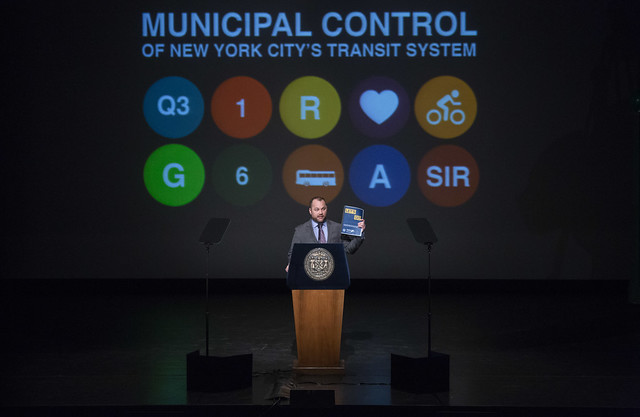
Council Speaker Corey Johnson (photo: John McCarten/City Council)
With subway and bus riders so frustrated with poor service, it is understandable that city leaders are talking about changing the governance of the MTA and its New York City Transit (NYCT) division as a solution.
Most notably, City Council Speaker Corey Johnson has come up with a well-intentioned but ultimately misguided plan to break NYCT off from the MTA and vest full responsibility for its funding and operation in a mayor-controlled structure he’s named Big Apple Transit, or BAT. BAT would run the city transit used by millions of New Yorkers every day.
The speaker and I, along with MTA Board member Veronica Vanterpool and moderator Charles Komanoff, appeared Wednesday evening on a panel to discuss his plan, part of the Theodore Kheel Fellowship Program at Roosevelt House at Hunter College.
The appeal of the speaker’s plan has been enhanced by Governor Cuomo’s pre-election (and continuing, although to a lesser extent) protestations that neither he nor anyone, really, controls the MTA and is responsible for improving how it operates.
But shifting from MTA to city government control would only substitute New York City-centric political challenges for regional ones, and could well make some of the system’s problems worse. Attention and effort would more usefully be focused on reminding the current MTA Board of its fiduciary responsibility to the agency, not to the Governor, demanding more transparency and requiring serious oversight by the State Legislature.
It is far easier to argue for city control of subways and buses than to get into the weeds of how to reform MTA procurement, why and how to install a new signal system, or the need for work rule changes in union contracts. But these are the dynamics that need change the most.
There are several reasons why a shift in control of subways and buses from a regional to a city authority would be problematic.
First, the separation of city buses and subways from the rest of the MTA’s assets runs counter to the long-term goal of creating a more integrated regional transit system. More than 1.1 million people commute into New York City to work. They swipe their metrocards half-a-million times a day. We need these workers to contribute to the city’s economy, shop, and pay sales taxes in addition to bridge tolls and fares that help support the buses and subways. We need to be thinking about how to better connect Westchester and Long Island transit systems (and yes, New Jersey and Connecticut as well) to the city’s, not allow them to exist in siloes.
Second, even if it were desirable, a new Big Apple Transit would not be financially viable. We have a Metropolitan Transit Authority because it serves, and derives revenue from, seven suburban counties in addition to the five boroughs of New York City.
The Payroll Mobility Tax and the dedicated regional sales tax are levied on businesses and activities in the region with suburban counties as well as residents and businesses paying a significant share. In particular, the PMT generates more than $1 billion per year for NYCT. This tax was vehemently opposed by suburban legislators when it was adopted in 2009 and it has repeatedly been subjected to various exceptions. The state Legislature agreed to make up some of the lost revenue from the exemptions.
Can there be any doubt that if NYCT were separated from the regional MTA the state Legislature would quickly and gleefully cease providing the lost revenue from the exemption from the PMT and might well suspend or redirect other regional taxes designated for the MTA exclusively to the LIRR and Metro North?
This could mean that city residents and businesses would be required to make up the loss of some of the $2 billion in annual revenue from sales taxes, ride-hail surcharges, mortgage transfer fees, etc. now devoted to the NYCT. Even if replacement of these revenues with local taxes were acceptable to the public(!), there is no guarantee that the state Legislature would grant New Yor City authority to impose them.
And the subsidy from general state revenue would be at risk as well. The governor has made his view on this clear: “If New York City took [transit] over, they take it over. They don’t get the state funding.”
Speaker Johnson’s proposal assumes that all regional and state subsidies to NYCT would remain in place and even then, he projects the city would need to come up with an additional $1-1.5 billion in revenue a year. The loss of any or all state and regional support, totaling almost $3 billion a year, could make the shortfall overwhelming and would require significant increases in fares and other taxes. And the shortfall would be even worse if there is a recession.Will city taxpayers and riders put up with absorbing all of that?
It is of course undeniable that the MTA Board structure obscures accountability. But it is necessary and appropriate for a regional transit system to have representation of all the impacted counties on its board.
Nonetheless, the Mayor has more appointees than anyone besides the Governor, who also appoints the CEO/Chair. After all the drama of the last year over service disruptions, the declaration of a state of emergency to expedite repair work, the announcement of the Fast Forward Plan, and the governor’s last-minute intervention and rejection of the planned shutdown of the L line for a modified plan, it is now abundantly clear that the buck stops with the Governor.
Yes, the Board needs to fulfill its fiduciary responsibilities, be more transparent and exercise better oversight, but merely switching ultimate responsibility from one elected official to another will not change the fact that, so long as public transit is a public responsibility, it will have political leadership that shies away from making tough decisions.
To properly maintain and improve 24-hour bus and subway service, fares need to be regularly and steadily raised. Service needs to be suspended on some lines for periods of time so they can be properly maintained and repaired. A Board appointed by the Mayor will not find these decisions any easier than one controlled by the Governor, especially if it has to generate even more revenue because of the absence of state and regional tax support.
It is clear that one of the main drivers of NYCT cost growth is personnel. Why will the Mayor be any more likely than the Governor to resist the power of the Transportation Workers Union (TWU) and other labor unions? Notwithstanding Governor Cuomo’s intervention in 2014 to forge a contract settlement with transit unions – with no productivity initiatives or fringe benefit savings to offset wage increases – TWU head John Samuelson is already threatening a strike in response to recent exposés on overtime abuses and related criticism. A Mayor would be even more susceptible to these kinds of threats.
Disjointed regional transit planning and administration, possible loss of substantial state and regional funding, a fraught environment in which to implement fare increases, raise taxes, and negotiate labor contracts – these are the likely results of “blowing up the MTA.” Better to focus on practical, feasible steps to make the MTA work better right now. Reinvent Albany recently published a report with 50 Actions New York Can Take To Renew Public Trust in the Metropolitan Transportation Authority that contains many worthwhile proposals. Among the most significant:
-The MTA Board should vote on policy decisions, not adopt them de facto though contract approvals.
-The Senate and Assembly should create committees dedicated specifically to oversight of the MTA, not treat it as part of the general Transportation or Authorities Committee jurisdiction where the MTA region are not well-enough represented.
-MTA Board members should be subject to a real, thorough vetting and confirmation process.
-There should be much more open data on contracts, project progress, budget and capital planning.
-The MTA fiscal year should be moved to begin in July instead of January, so state budget actions can be taken into account in financial planning.
-Procurement should be streamlined so there are fewer incentives for change orders and cost overruns.
Instead of devoting time and attention to the idea of putting different people in the seats on the deck of the Titanic, let’s work on getting the ship into stable waters and smooth sailing by insisting on competence and accountability from the crew we have.
***
Carol Kellermann was president of Citizens Budget Commission from 2008 through 2018.
***
Have an op-ed idea or submission for Gotham Gazette? Email This email address is being protected from spambots. You need JavaScript enabled to view it.
***
Have an op-ed idea or submission for Gotham Gazette? Email This email address is being protected from spambots. You need JavaScript enabled to view it.
We Can Help Thousands More Residents of Affordable Housing Register to Vote
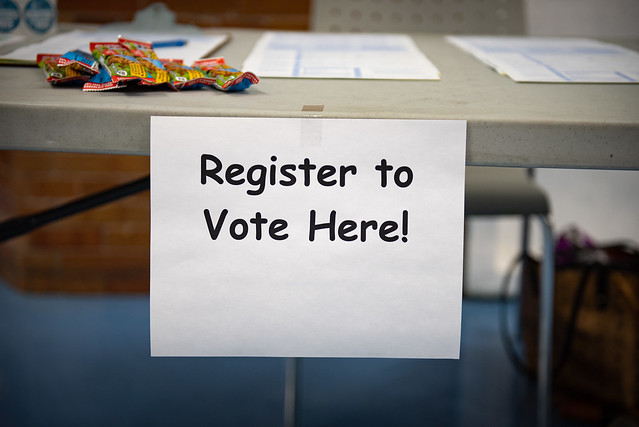
(photo: Michael Appleton/Mayoral Photography Office)
No one’s socioeconomic status should limit their capacity to make their voice heard at the ballot box. But more must be done to ensure that low-income populations across the nation are registered to vote and can participate in the democratic process.
We can help address this issue in New York by taking more information directly to residents in and around their own apartment buildings. Managers of affordable housing developments can play a significant role in connecting tenants with the information needed to register to vote.
That is why NYSAFAH is launching a non-partisan voter registration initiative that will target residents of affordable housing developments that are managed by our members. Through this effort, we can help thousands more low-income New Yorkers register to vote by the end of this year.
NYSAFAH is the state’s trade association of affordable housing developers, managers, architects, planners, and others who help build and preserve homes for low- and middle-income New Yorkers.
Our first priority is to deliver quality housing for New Yorkers. However, being good stewards of affordable housing often extends beyond the day-to-day maintenance of four walls and a roof.
Our members also impact the lives of their residents by helping them access social services, participate in recreational programming and engage in other activities that contribute to strong families and healthy living. We believe that working to increase rates of voter registration can become an important part of that broader mission.
As part of our new initiative, NYSAFAH will partner with the New York City League of Women Voters to advance a coordinated outreach campaign that is driven by direct engagement with residents. This outreach will include voter registration drives held at buildings in which residents live. At these sessions, managers will provide non-partisan guidance and information with the goal of maximizing voter registration among the resident population.
NYSAFAH members collectively manage hundreds of buildings across the five boroughs, with tens of thousands of residents overall. This makes for an even greater opportunity to have a real impact on boosting rates of voter registration among low-income communities throughout New York.
As we make progress on this front, we will also be taking an important first step toward advancing the broader goal of increasing voter participation – when more of us vote, we all benefit from a stronger democracy.
And after all, this just makes sense. When it comes to engaging with residents, why not start with a renewed effort to give them more of the tools they need right at home?
We have already received a great deal of positive feedback from NYSAFAH members who are excited to embark on what we all believe will be a crucial initiative for our state. Our team looks forward to seeing thousands more New Yorkers registered to vote – and we hope that this work can serve as a model for future initiatives to keep advancing the ball.
***
Jolie Milstein is president and CEO of the New York State Association for Affordable Housing (NYSAFAH). On Twitter @NYSAFAH.
***
Have an op-ed idea or submission for Gotham Gazette? Email This email address is being protected from spambots. You need JavaScript enabled to view it.
T-Mobile-Sprint Merger Will Help Those Who’ve Been Left Behind in the Digital Age
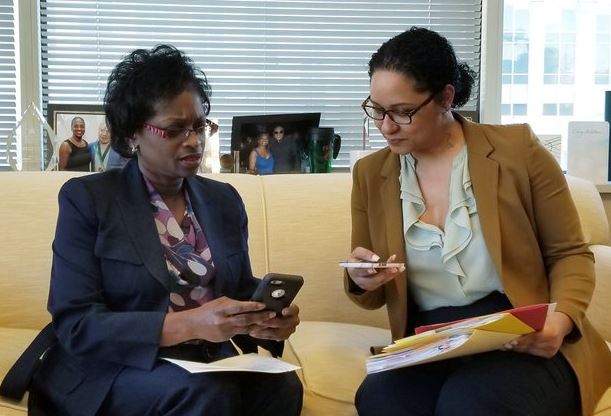
Mignon Clyburn, the author, left (photo: @MignonClyburn)
Wireless broadband should reach communities of color at the same time it reaches most of the U.S. population.
Why do I say this…or is the question really, why am I still saying this in 2019?
While serving nine years as a Federal Communications Commissioner, I saw firsthand how wireless broadband access expands access to jobs, enriches education, and deepens political engagement. Losing out on wireless broadband opportunities today increases the risk of us losing out on just about everything the future holds.
In a recent roundtable discussion at New York Law School about “5G,” the next generation of wireless technology, I spoke about how both government and industry need to keenly focus on ensuring that underserved communities receive the anticipated benefits of 5G sooner rather than later. And, in my view, approving the T-Mobile/Sprint merger is one of the best ways to ensure inclusive broadband deployments.
T-Mobile, which I am currently advising, has long been an ally of underserved consumers. You find their stores in markets other providers avoid, and the company has doubled down and broadened access to key communications and technological services.
Consider T-Mobile's investments in MetroPCS, the prepaid brand it acquired in 2013, and you will find an unwavering commitment to cost-conscious communities. And that's not all—T-Mobile has helped hundreds of thousands of Americans, including thousands of New Yorkers, build a credit history by enabling, and in many cases encouraging, a transition from prepaid to postpaid phone plans. T-Mobile has bridged the gap between Metro and postpaid phone plans, allowing Metro customers to have a comparable experience to those on postpaid plans.
The merger with Sprint will enable a massive new investment by T-Mobile—nearly $40 billion, to be exact—to create an inclusive, nationwide 5G network and services that will greatly improve access to broadband for all New Yorkers, not just the wealthy.
In my time at the FCC, I worked on expanding wireless service in underserved neighborhoods because I recognized early on that broadband connectivity offers an ever-present stepping stone for upward mobility. Now in 2011, I opposed the proposed AT&T/T-Mobile merger, in part because AT&T already controlled 44 percent of the market. But unlike that deal, the T-Mobile/Sprint merger will combine the two smallest nationwide providers and strengthen a maverick that can better compete against two dominant players.
From Bed-Stuy to Buffalo, the combined company’s expansive deployment plan promises to bring us closer to bridging the digital divide, and it will do so in an affordable way.
The companies have pledged to offer the same services T-Mobile and Sprint currently offer at the same prices for three years or until better plans that offer lower prices or more data are made available. This means that competition will quickly heat up and prices will likely come down as other carriers feel the heat.
No one stands to benefit more from this fierce competition than those currently underserved. Research, including the work of Brookings Institution expert Nicol Turner Lee, shows that lower-income Americans are the most likely to rely on wireless as their primary or sole means of connecting to the internet. The 5G network enabled by the T-Mobile/Sprint merger will allow customers who can’t afford expensive in-home broadband to access broadband-equivalent speeds on their phones.
While at the FCC, I was proud to have strengthened the Lifeline program, which subsidizes wireless service for those who otherwise could not afford it. T-Mobile and Sprint have not only committed to continue supporting this important service in New York and across the country, but they will also maintain support for programs like Sprint's 1Million Project, which provides service and devices to worthy high school students.
The New York Public Service Commission has already approved the merger of T-Mobile and Sprint, and I hope that those who are still reviewing the transaction at the federal and state levels will not stand in the way.
The status quo is not acceptable. What is needed is for a proven wireless industry disruptor to expand on a larger scale, bringing wider and better connectivity opportunities to New Yorkers as we move into the 5G era. For those currently on the wrong side of the digital divide, change cannot come soon enough.
***
Mignon Clyburn served as Federal Communications Commission Commissioner from 2009 to 2018, and is currently an adviser to T-Mobile. On Twitter @MignonClyburn.
***
Have an op-ed idea or submission for Gotham Gazette? Email This email address is being protected from spambots. You need JavaScript enabled to view it.
Social Workers for Homeless Kids is Not the Place to Skimp
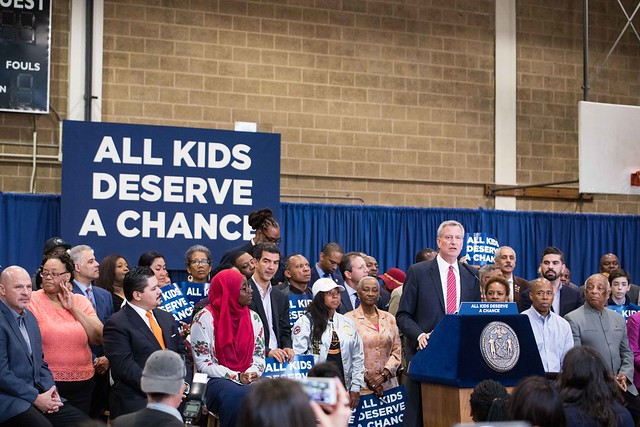
(photo: Benjamin Kanter/Mayoral Photo Office)
Last year, nearly 38,000 New York City students arrived in the classroom having woken up in a shelter. That’s more students than the total enrollment of the Buffalo public schools, the next largest school district in the state.
Many had been exposed to domestic violence, one of the driving forces of homelessness. Many were forced to transfer schools mid-year, some multiple times, after being placed in a shelter in an entirely different borough. Some were in placements with no kitchen or laundry machine. More than half missed the equivalent of an entire month of the school year due to absences.
Imagine being dropped abruptly mid-year into a classroom where you know no one and have to get used to a new school—all while wondering how long your family will have to stay in a shelter. Imagine having 50 students in this situation—two full kindergarten classrooms of children—come into your school every day, and not having any additional staff to focus on supporting them.
For many students and schools, this is reality.
As the number of children experiencing homelessness has skyrocketed, it is essential that schools serving large numbers of students living in shelter have trained professionals dedicated to meeting their needs.
Three years ago, Mayor de Blasio launched a program to place 33 “Bridging the Gap” social workers in schools with high concentrations of students living in shelter. This year, with additional funding from the mayor and the City Council, there are 69 Bridging the Gap social workers. These social workers provide much-needed counseling to address the trauma that can interfere with the school performance of students living in shelters and work to address barriers to regular school attendance.
However, far too many schools still lack this critical support. In fact, 100 schools have 50 or more students living in shelter and no Bridging the Gap social worker.
We were baffled that, for the third year, instead of increasing funding for Bridging the Gap social workers, Mayor de Blasio omitted all funding for this program from his preliminary budget, jeopardizing its continuation.
Following an outcry from Council members and advocates, the mayor restored funding for 53 of the 69 social workers in his executive budget last month. While we were pleased that the mayor included long-term (“baselined”) funding for the 53 social workers, ending the annual budget dance, we were disheartened that 16 social workers remained at risk, especially when we need even more than 69.
Following further criticism, the administration announced that it would restore funding for the remaining 16 social workers just before the City Council began its executive budget hearings last week.
The administration has cited the restoration of the Bridging the Gap social workers as a key way that it has been responsive to the Council’s priorities. But the Council has asked for an increase—not merely a restoration—of the program.
In fact, 35 Council members, as well as shelter providers and education advocates, have called on the mayor to add $5 million to the budget to increase the number of Bridging the Gap social workers from 69 to at least 100.
Cutting funding for the program and then restoring it should not be viewed as a victory when thousands of students living in shelter lack access to the crucial help Bridging the Gap social workers can provide.
Schools alone cannot end homelessness. But, with the right support, schools can transform the lives of students who are homeless. As Mayor de Blasio has stated, a quality education is “the most powerful tool we know for lifting one’s life chances.”
To break the cycle of homelessness, the city must devote more attention and resources to the education of students living in shelter. The mayor should start by providing funding for at least 100 school social workers for students living in shelter in this year’s budget.
***
Kim Sweet is Executive Director of Advocates for Children of New York. On Twitter @AFCNewYork.
***
Have an op-ed idea or submission for Gotham Gazette? Email This email address is being protected from spambots. You need JavaScript enabled to view it.
Care about Climate Change? Care About Scooters

(photo: Lime)
Solving our biggest global crisis of a rapidly warming planet means considering everything through the lens of potential solutions, even something as small as the electric scooter.
Micromobility is rightfully capturing the keen attention of urbanists around the world -- including the much-discussed e-scooter. And New York is poised to take advantage as well.
Simultaneously, New York is considering various necessarily ambitious policies to combat climate change and legislation to authorize local governments to roll out micromobility programs. Statewide, transportation is the number one source of carbon emissions, so these revolutions are closely related.
But New York must act decisively -- and quickly -- on both issues if it is going to start reducing its carbon footprint at a rate that allows it to reach its global warming goals and to prevent the harmful health effects of local pollution.
A recent International Panel on Climate Change (IPCC) report concluded we have 12 years to prevent the worst of climate impacts. Subsequent reports find our climate pollution emissions have continued to accelerate. Arctic melting has, as well. New York has already felt the dramatic and tragic effects of climate change, enduring the terrible power of Hurricane Sandy.
So any chance to significantly reduce the effects of climate change must be taken, especially when it improves other aspects of daily life. That’s where micromobility offers a tremendous opportunity.
Take the electric scooter itself, an under 50-pound mode of transit. Scooters stand in stark contrast to one- and two-ton cars, and the energy it takes to move them and space consumed to park them. Right now, two-thirds of trips made by car are under one mile. That’s a massive waste of energy when a large number of those trips are just one able-bodied person who could easily -- and often more quickly -- use a carbon-neutral option like a scooter.
People have noticed this when they have access to scooters, and the change trend is already well underway. They have taken shared scooters on over 50 million rides in the last year alone.
Moreover, independent studies by city transportation departments and internal company research have both found a roughly one-third, or often more, mode-shift in cities from scooters. This means one out of every three scooter rides is a trip not taken by ride-hailing, taxi, or personal vehicle, and when most vehicles are still one to two ton gas burning cars, that's a big deal for climate pollution.
It is also a big deal for public health, as local pollution afflicts people with health complications like asthma, and more often the urban young and old and people of color, a threat equal to a history of smoking.
For the New York City metro area, 100,000 shared scooters and bikes could easily prevent more than 300,000 car trips each day. That would also prevent nearly 50,000 tons of carbon annually and 4 tons of asthma-inducing particulates.
Right now, we need government leaders at all levels to have an Apollo-like mindset to the climate crisis and, as a result, measure every major policy decision through the lens of the climate fight. Scooters and electric micromobility are just one of the myriad of solutions we will need to deploy now to have a chance of making an impact on this global challenge.
We’ve done this before. During World War II, every major policy decision was put through the filter of the war effort. That allowed us to turn our economy into a giant cog of mission-oriented productivity, going, for example, from a production of just 3,000 bombers to a staggering 300,000 in those few years.
It’s time to make bold changes in the effort against this climate crisis. If this is our modern World War III, we'd better get moving, big and small, on city streets across the globe. New York can do its part by authorizing micromobility statewide right now.
***
Andrew Savage is vice president of sustainability and a founding team member of Lime, a mobility company that makes scooters, bikes, and more. He is a veteran of local, state, and federal government. On Twitter @limebike.
***
Have an op-ed idea or submission for Gotham Gazette? Email This email address is being protected from spambots. You need JavaScript enabled to view it.